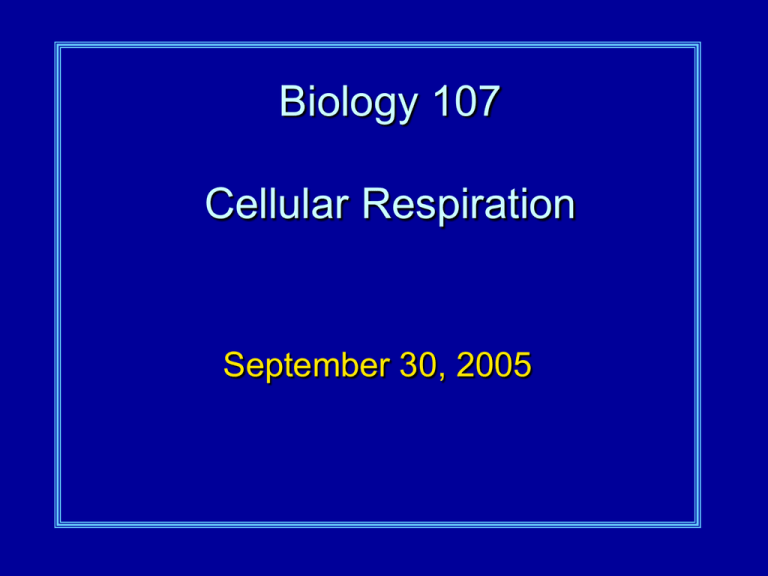Biology 107 Cellular Respiration September 30, 2005
advertisement

Biology 107 Cellular Respiration September 30, 2005 Cellular Respiration II Student Objectives: As a result of this lecture and the assigned reading, you should understand the following: 1. Respiration occurs in two (2) stages: 1) the Krebs cycle (citric acid cycle) and 2) the terminal electron transport chain. 2. In eukaryotes these respiration reactions take place in mitochondria. 3. Some enzymes of the Krebs cycle are in the matrix of mitochondria; other enzymes of the Krebs cycle and the enzymes of the electron transport system are in the membrane of the cristae of the inner membrane. The outer membrane is relatively permeable, while the inner membrane restricts passage of most molecules and ions, including protons (H+ ions). Cellular Respiration II 4. Compared to glycolysis, the Krebs cycle pays off big energy dividends to the cell. a. Each turn of the cycle makes 1 ATP molecule (by substrate level phosphorylation) and 4 other energy-rich molecules (3NADH and 1 FADH2). b. Since two molecules of acetyl CoA are processed for each glucose precursor, the total yield is 2ATP, 6NADH, and 2 FADH2 (compared to the total of 2ATP and 2NADH molecules of glycolysis). 5. No oxygen is required for the Krebs cycle. Cellular Respiration II 6. After the Krebs cycle is completed, glucose is completely oxidized, but most of the energy is stored in electrons moved from carbon atoms to the electron carriers NAD+ and FAD. 7. In terminal electron transport, the high energy electrons stored in the NADH and FADH2 carriers are passed step-by-step to successively lower energy carriers embedded in the inner membrane of the mitochondrion until the electrons are finally accepted by the low energy level oxygen atom. 8. As the electrons are passed down the electron transport chain, H+ are transported from the matrix across the inner mitochondrial membrane to the intermembrane space and a concentration gradient of hydrogen ions is produced. Cellular Respiration II 9. The theory of chemiosmotic coupling explains how the concentration gradient of H+ is used to generate energy to make ATP. a. The enzyme complex ATP synthase synthesizes ATP using the energy stored in the concentration gradient of H+ ions (i.e., protons) across the inner membrane, which is relatively impermeable to H+. b. The H+ ions tend to move down their concentration gradient toward the matrix of the mitochondrion. Movement through the ATP synthase is used to generate the ATP from ADP and inorganic phosphate. 10. The process of generating ATP from the electron transport chain is called oxidative phosphorylation. Cellular Respiration I 11. Fats, complex carbohydrates, and proteins may be funneled into glycolysis or the Krebs cycle. The most common convergent point is acetyl CoA. 12. In prokaryotic cells (which lack mitochondria) the oxidative reactions are distributed between the cytoplasm and the plasma membrane. Aerobic Respiration Occurs in the Eukaryotic Mitochondrion and Includes the Krebs Cycle and the Electron Transport Chain/Oxidative Phosphorylation Pyruvate is Converted into Acetyl CoA to Enter the Krebs Cycle Pyruvate is Transported into the Mitochondrion and Converted to the 2-Carbon Acetyl CoA Steps of the Krebs Cycle General Organization of the Electron Transport Chain Electron Transport Chain Establishes a H+ Gradient Across the Inner Membrane The Movement of H+ Down Its Concentration Gradient Generates ATP Summary of Cellular Respiration Catabolic Pathways Catabolic Pathways Example of Regulation Mechanisms for Catabolic Pathways



